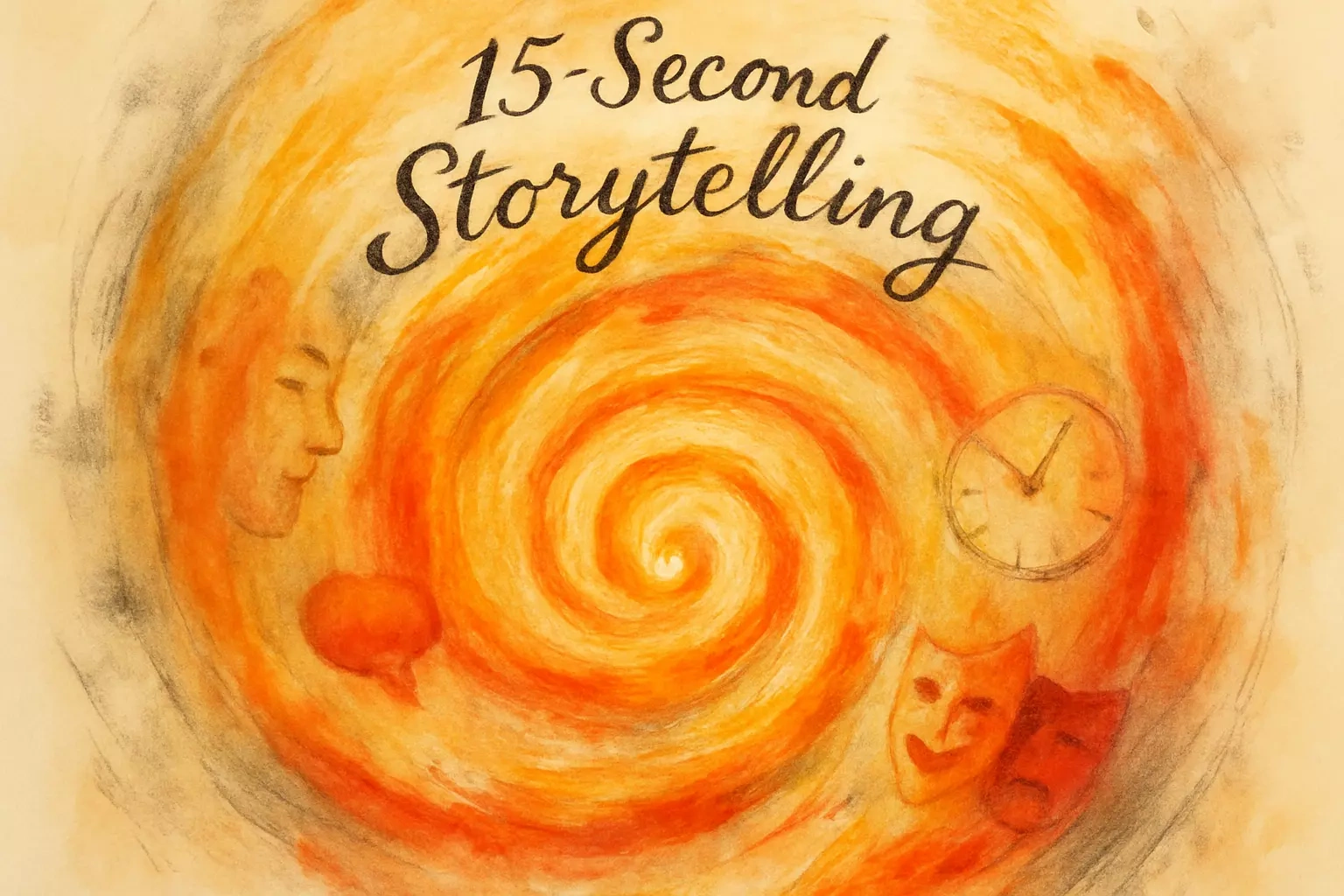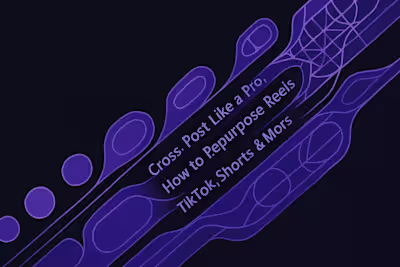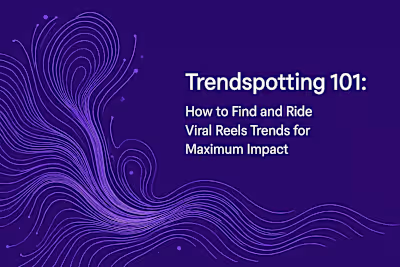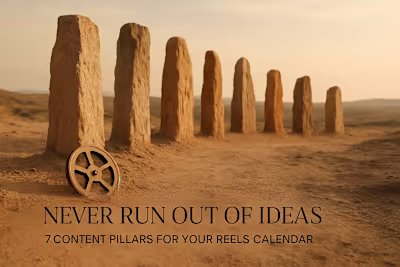15-Second Storytelling: A Guide to Captivating Your Audience in a Flash

15-Second Storytelling: A Guide to Captivating Your Audience in a Flash
The Anatomy of a 15-Second Story
The Hook (Seconds 1-3)
The Middle: The Core Message
The Payoff: The Conclusion or CTA
Proven Storytelling Frameworks for Reels
The 'Problem/Solution' Framework
The 'Before and After' Transformation
The Quick Tip or 'How-To'
The Relatable Experience (POV)
Enhancing Your Story with Visuals and Audio
Pacing and Dynamic Editing
On-Screen Text as a Narrative Guide
Matching Audio to the Mood
Conclusion
References
15-Second Storytelling: A Guide to Captivating Your Audience in a Flash
In the world of short-form video, you have mere seconds to capture attention and tell a story. Think about it—when was the last time you stopped scrolling because something instantly grabbed you? That's the power of mastering 15-second storytelling. It's a skill that can hook viewers, deliver a memorable message, and drive real action.
But here's the thing: creating compelling short videos requires a totally different approach than traditional content. You need a killer hook and a story so tight it could fit on a napkin. The good news? This skill pairs perfectly with staying on top of the latest trends and finding endless inspiration for your next viral hit. And if you're looking to level up fast, you can always hire a storytelling expert to help craft your narrative.
The Anatomy of a 15-Second Story
Every effective short-form video follows a basic narrative structure. Yes, even those silly dance videos have a beginning, middle, and end. Understanding this framework is like having a secret recipe—once you know it, you can whip up engaging content in minutes.
Think of your 15-second story as a mini movie. It needs all the same elements as a blockbuster film, just compressed into bite-sized pieces. The difference? You don't have time for character development or complex plot twists. Every second counts, and every frame needs to earn its place.
The Hook (Seconds 1-3)
Let's be real—the first three seconds are make or break. Your hook needs to be strong enough to stop someone mid-scroll. And trust me, that's no easy feat when people's thumbs are moving at lightning speed.
So what makes a great hook? It could be a provocative question that makes viewers think "Wait, what?" Or maybe a bold statement that challenges what they believe. Visual surprises work wonders too—like starting with an unexpected image or a quick, dynamic movement that catches the eye.
Here's a pro tip: start your video with movement. Our brains are wired to notice motion, so even something as simple as a hand gesture or a quick zoom can be enough to pause the scroll. The key is making those first moments impossible to ignore.
The Middle: The Core Message
Now that you've got their attention, you need to deliver. This is where you quickly build on your hook and get to the meat of your story. Maybe you're setting up a joke, demonstrating a problem, or building anticipation for a big reveal.
The trick here is to keep things moving. You can't afford to lose momentum. Use visual variety—switch angles, add text overlays, or incorporate quick cuts. Remember, you're not just telling a story; you're creating a visual experience that keeps eyes glued to the screen.
Your core message should flow naturally from your hook. If you started with a question, this is where you begin answering it. If you opened with a problem, now's the time to hint at the solution. Keep it tight, keep it focused, and most importantly, keep it visually interesting.
The Payoff: The Conclusion or CTA
The end of your Reel needs to stick the landing. This is your moment to deliver that satisfying conclusion viewers didn't know they needed. It could be a punchline that makes them laugh, a solution that makes them think "I need to try that," or a transformation that leaves them amazed.
Your payoff should feel inevitable yet surprising. It's like the perfect ending to a joke—once you hear it, you can't imagine it ending any other way. And don't forget your call-to-action. Whether you want viewers to follow, share, or try something themselves, make it crystal clear what their next step should be.
Proven Storytelling Frameworks for Reels
Here's some good news: you don't have to reinvent the wheel every time you create content. There are tried-and-true storytelling frameworks that work like magic for short-form video. Think of these as templates you can customize for your own unique spin.
These frameworks exist because they tap into fundamental ways humans process information. We're naturally drawn to certain narrative patterns, and smart creators use this to their advantage. Let's break down the most effective ones.
The 'Problem/Solution' Framework
This framework is pure gold for business content. Start by presenting a common pain point your audience faces—something that makes them think "Ugh, yes, that's so annoying!" Then boom, reveal your product or service as the perfect solution.
The beauty of this approach is its simplicity. In just 15 seconds, you can identify with your audience's struggles and position yourself as their hero. For example, start with "Tired of spending hours editing videos?" then show your editing service in action. It's straightforward, relatable, and incredibly effective.
The 'Before and After' Transformation
Nothing grabs attention quite like a dramatic transformation. Our brains love seeing change happen right before our eyes. This could be a room makeover, a fitness transformation, or even a simple recipe coming together.
The key is making the contrast as stark as possible. Start with the "before" state—messy, problematic, or incomplete. Then use dynamic transitions to reveal the stunning "after." The visual impact alone is often enough to stop scrollers in their tracks. Plus, transformations naturally create curiosity about the process, encouraging viewers to watch again or check out your other content.
The Quick Tip or 'How-To'
People love learning something new, especially when it only takes 15 seconds. This framework positions you as the expert while providing immediate value to your audience. The trick is choosing tips that are genuinely useful but simple enough to demonstrate quickly.
Start with a clear promise: "Here's how to..." or "The secret to..." Then deliver on that promise with clear, visual steps. Maybe you're showing a photography trick, a cooking hack, or a productivity tip. Whatever it is, make sure viewers can actually implement it after watching once or twice.
The Relatable Experience (POV)
POV (Point of View) Reels are having a major moment, and for good reason. They tap into shared experiences that make viewers feel seen and understood. These videos often start with "POV: You're..." followed by a scenario your audience knows all too well.
The magic happens when viewers think "That's literally me!" Whether it's the chaos of Monday mornings, the awkwardness of networking events, or the joy of Friday afternoons, these videos create instant connection. They work because they transform individual experiences into communal moments of recognition and often, laughter.
Enhancing Your Story with Visuals and Audio
Here's where the rubber meets the road. You can have the best story idea in the world, but if your execution falls flat, viewers won't stick around. The good news? You don't need expensive equipment or years of film school to create engaging content.
Think of visuals and audio as the seasoning that brings your story to life. They're what transform a basic idea into something people want to watch again and share with friends. Let's dive into the techniques that'll take your content from amateur to addictive.
Pacing and Dynamic Editing
If there's one thing that separates engaging Reels from boring ones, it's pacing. Your video should feel like a rollercoaster, not a lazy river ride. Use quick cuts to maintain energy, but don't go so fast that viewers can't follow along.
Mix up your shots to keep things interesting. Close-ups, wide shots, overhead angles—variety is your friend. And here's a secret: even tiny movements like slight zooms or pans can add dynamism to otherwise static shots. The goal is to eliminate any "dead air" that might tempt viewers to keep scrolling.
Transitions are another powerful tool. A well-timed transition can emphasize your point, create surprise, or simply keep the visual flow smooth. But remember, less is often more. Choose transitions that serve your story, not ones that distract from it.
On-Screen Text as a Narrative Guide
Here's a reality check: most people watch Reels without sound. That's why on-screen text isn't just nice to have—it's essential. Think of text as your co-narrator, guiding viewers through your story even in silence.
But don't just transcribe everything you're saying. Use text strategically to emphasize key points, add context, or create visual interest. Bold important phrases to make them pop. Play with timing—sometimes revealing text word by word creates suspense and keeps viewers engaged.
Your text should complement your visuals, not compete with them. Keep it readable with good contrast and appropriate sizing. And please, for the love of all things viral, make sure your text stays on screen long enough to read comfortably.
Matching Audio to the Mood
Never underestimate the power of the right soundtrack. Audio sets the emotional tone of your video faster than any visual element. A trending song can instantly make your content feel current and relatable. A dramatic sound effect can turn a simple reveal into a moment of suspense.
The key is matching your audio to your story's emotional arc. Building to a big reveal? Use music that crescendos. Going for laughs? Find audio that enhances the comedic timing. Creating a calm, inspirational vibe? Choose something that makes viewers want to take a deep breath and smile.
Pay attention to audio trends too. Sometimes using the right trending sound can boost your visibility significantly. But always ask yourself: does this audio actually enhance my story, or am I just using it because it's popular?
Conclusion
Mastering 15-second storytelling isn't just about creating viral videos—it's about connecting with your audience in meaningful ways, even in the briefest moments. Every technique we've covered, from crafting irresistible hooks to choosing the perfect audio, serves one purpose: telling stories that resonate.
Remember, the best Reels don't feel like ads or forced content. They feel like moments of genuine connection, entertainment, or value. Start with one framework that resonates with your style, experiment with different visual techniques, and always keep your audience's experience front and center.
Your next viral Reel is just 15 seconds away. So grab your phone, pick a framework, and start creating. The world is waiting for your story—make it one they'll never forget.
References
Like this project
Posted Jun 30, 2025
Attention spans are short. Learn the art of 15-second storytelling with powerful hooks, clear narrative structures, and compelling visuals to master Instagram Reels.








